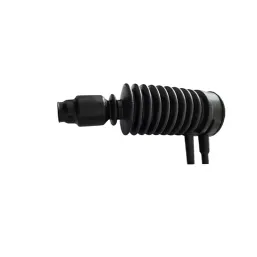rubber protector
Material Options
The material selection for rubber protector plays a critical role in ensuring durability, flexibility, and resistance to various conditions. Common materials include:
- Natural Rubber (NR):Offers excellent elasticity, resilience, and resistance to wear. It is ideal for general-purpose applications where moderate temperature and environmental conditions are expected.
- Nitrile Butadiene Rubber (NBR):Known for its oil and fuel resistance, NBR is suitable for applications involving exposure to petroleum-based substances.
- Ethylene Propylene Diene Monomer (EPDM):Provides superior weathering and UV resistance, making it perfect for outdoor applications.
- Silicone Rubber:Ideal for high-temperature environments due to its excellent heat resistance and flexibility at low temperatures.
- Chloroprene Rubber (Neoprene):Combines good mechanical strength with resistance to sunlight, ozone, and chemicals.
Customization of materials allows manufacturers to select the most appropriate type based on the intended use of the protector, ensuring optimal performance under specific conditions.
Customizable Sizes
rubber protector come in a wide range of sizes to accommodate different thread diameters and lengths. The dimensions can be customized according to customer requirements, ensuring a snug fit that prevents slippage or misalignment. Key parameters include:
- Inner Diameter (ID):Matches the outer diameter of the thread being protected.
- Outer Diameter (OD):Determines the overall size of the protector.
- Length:Adjusted based on the length of the thread requiring protection.
Manufacturers often provide charts or tables specifying available sizes and tolerances, enabling customers to choose the right protector for their application.
Design Flexibility
The appearance of rubber protector can be designed to suit specific functional or aesthetic needs. This includes:
- Color Customization:Available in various colors, such as black, white, red, blue, or custom shades. Color coding can help identify different types of protectors or simplify inventory management.
- Logo Printing:Corporate logos or branding can be printed on the surface of the protector, enhancing product recognition and promoting brand identity.
- Surface Texture:Options include smooth, ribbed, or grooved surfaces, depending on grip requirements or aesthetic preferences.
- Structural Enhancements:Features like reinforced edges or embedded metal inserts can improve durability and ease of installation/removal.
Design flexibility ensures that rubber protector not only serve their primary function but also align with the visual and operational standards of the end user.
Applications Across Industries
The versatility of rubber protector makes them indispensable in numerous industries:
- Automotive Industry:Protects engine components, fasteners, and assemblies during production and transport.
- Aerospace Sector:Ensures the integrity of critical components in harsh operating conditions.
- Construction Field:Prevents damage to bolts, screws, and other threaded hardware during building projects.
- Oil and Gas Industry:Safeguards equipment parts exposed to corrosive environments.
- Consumer Goods Manufacturing:Maintains quality control by protecting threaded components during packaging and shipping.
Environmental Considerations
In today’s environmentally conscious world, many manufacturers offer eco-friendly options for rubber protector. These may include recyclable materials, biodegradable formulations, or reduced waste production during manufacturing processes. Such initiatives align with global sustainability goals while meeting industry demands.
Conclusion
rubber protector are vital tools for safeguarding threaded components against damage and degradation. With customizable materials, sizes, and designs, they cater to diverse applications across multiple industries. By selecting the right combination of features, users can enhance product longevity, improve operational efficiency, and contribute to sustainable practices. Whether for everyday industrial use or specialized applications, rubber protector remain a cost-effective solution for protecting valuable assets.This detailed introduction highlights the importance of these components and underscores the value of customization in achieving optimal results for every application.








































